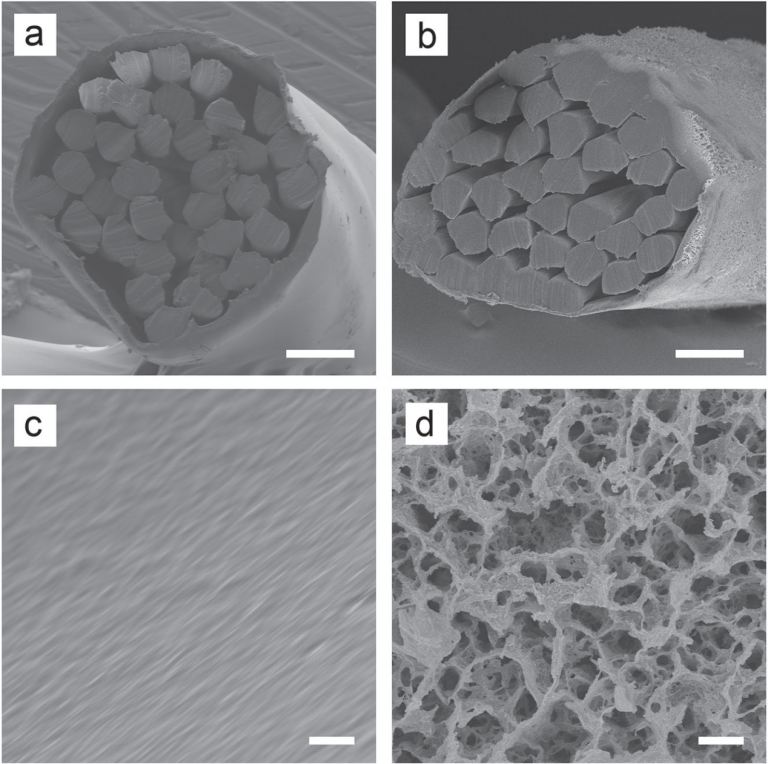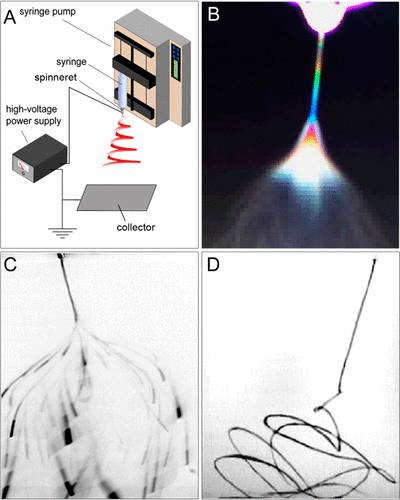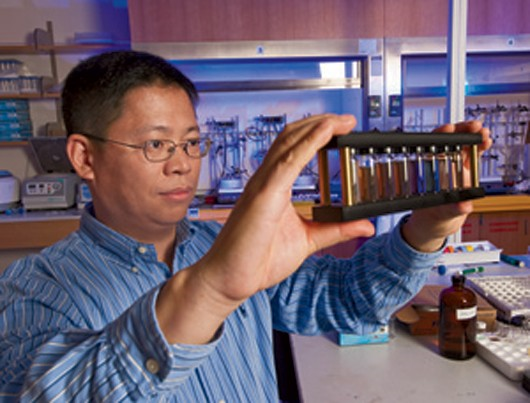Carding: Xia Younan‘s research results in recent years
QQ Academic Group: 1092348845
Detailed
Biography
Born in 1965, he graduated from Jingjiang Senior High School in Jiangsu Province. He was admitted to the Department of Modern Chemistry of the University of Science and Technology of China in 1982. He received a Guo Moruo Scholarship in 1986, a bachelor‘s degree in 1987, and a Ph.D. . He studied in the United States in 1991, obtained a master‘s degree in inorganic chemistry from the University of Pennsylvania in 1993, and a Ph.D. in chemistry and chemical biology from Harvard University in 1996 , under the supervision of Professor George M. Whitesides. Professor Xia has published more than 680 academic papers in top international journals such as Science, Nature, JACS, Angewandte Chemie International Edition, etc. The total number of citations has exceeded 80,000 times and the H factor is 169. Professor Xia has won several internationally renowned academic awards, including the American Chemical Society (ACS) National Materials Chemistry Award; the NIH Dean Pioneer Award; the American Chemical Society Beckland Award (the highest honor in the American Materials Chemistry community, according to the American Chemical Society) Professor Xia is the first Chinese chemist to win the Beckland Prize in sixty years; the Parker Foundation Scientific Engineering Research Award; the Sloan Research Award; and the American Chemical Society Lamel Award. In addition, Professor Xia has been an associate editor of Nano Letters, an internationally renowned academic journal since 2002, and concurrently serves as an advisor to several internationally renowned journals such as Accounts of Chemical Research, Advanced Functional Materials, Advanced Healthcare Materials, Angewandte Chemie International Edition and Nano Today. Committee member.
Thesis results:
Adv. Funct. Mater .: Phase change material with electrospun fibers promotes neurite growth

A team from Georgia Institute of Technology Xia Younan (corresponding author) studied the above system, which is based on particles made using coaxial electrospray, the external solution contains phase change material (PCM) and the internal solution contains a payload. When the temperature is kept below the melting point of the PCM, there is no release due to very slow diffusion through the solid matrix. At elevated temperatures to slightly exceed the melting point, the package‘s payload can be easily released from the molten PCM. With the reversibility of the phase change, the payload can be released in pulsed mode by an on / off heating cycle. By sandwiching microparticles co-colored with NGF and near-infrared dye between two layers of electrospun fibers to form a three-layered construct, the potential use of the controlled release system in neural tissue engineering was evaluated. After photothermal heating with a near-infrared laser, NGF is released and has good biological activity to promote neurite growth. By selecting different combinations of PCM, biological effector and scaffolding materials, this controlled release system can be applied to a variety of biomedical applications. Related content was published on Advanced Functional Materials under the title " Integration of Phase-Change Materials with Electrospun Fibers for Promoting Neurite Outgrowth under Controlled Release " .
Literature link: Integration of Phase-Change Materials with Electrospun Fibers for Promoting Neurite Outgrowth under Controlled Release (Adv. Funct. Mater., 2018, DOI:
Adv. Mater .: "One Man Becomes Off, Wan Fu Mo Kai" Near-infrared controlled eutectic natural fatty acid phase change triggers drug release

Professor Xia Younan‘s team at Georgia Institute of Technology (corresponding author) has designed and prepared a new type of nano-drug-loading material. The eutectic mixture of two fatty acids can quickly respond to near-infrared light for controlled drug release. The material has good biocompatibility and temperature control repeatability. At the same time, when DOX and IR780 are loaded, both in vitro experiments and cell experiments can achieve the desired results—responding to near-infrared light to quickly release drugs and achieve the purpose of quickly killing tumor cells. The research results were published on the internationally renowned journal Adv. Mater. Under the title " A Eutectic Mixture of Natural Fatty Acids Can Serve as the Gating Material for Near-Infrared-Triggered Drug Release " .
Literature link: A Eutectic Mixture of Natural Fatty Acids Can Serve as the Gating Material for Near-Infrared-Triggered Drug Release (Adv. Mater., 2017, DOI: 10.1002 / adma.201703702)
Angew. Chem. Ind. Ed: Nano-hybrid materials for controlled free radical generation and oxidative destruction of hypoxic cancer cells

Georgia Institute of Technology Xia Younan Jiaoshou (corresponding author) reported the research group uses gold cage recent progress controllable generation of oxygen free radicals and oxidative damage of hypoxic cancer cells achieve the research results, entitled " A Hybrid Nanomaterial for at The "Controlled Generation of Free Radicals and Oxidative Destruction of Hypoxic Cancer Cells " was published in Angew. Chem. Ind. Ed . This work kills cancer cells by a new method that uses polymerization initiators to generate oxygen radicals. First, the polymerization initiator 2,2‘-azobis [2- (2-imidazolin-2-yl) propane] dihydrochloride (AIPH) and phase transition The materials (PEM) are mixed and encapsulated in the cavity of gold nanocages (AuNCs). After the near-infrared laser is initiated, the phase change material melts under the photothermal effect of the gold nanocages, thereby releasing the initiator to generate free radicals. It can oxidize cellular compounds, or react with oxygen to generate cytotoxic free radicals. In addition, it can also produce intracellular lipid peroxides even in hypoxic environments, which can cause apoptosis. The method can achieve efficient and controllable generation of oxygen free radicals in cancer cells with low oxygen content, can effectively kill cancer cells, and achieve the purpose of treating cancer.
Literature link: A Hybrid Nanomaterial for the Controlled Generation of Free Radicals and Oxidative Destruction of Hypoxic Cancer Cells (Angew. Chem. Int. Ed., 2017, DOI: 10.1002 / anie.201702898 / full)
JACS: One-Pot Preparation of Pd-Pt Bimetallic Nanocrystals with Different Structures and Its Genetic Analysis
On August 29, 2016, JACS published an article entitled "Quantitative Analysis of the Reduction Kinetics Responsible for the One-Pot Synthesis of Pd-Pt Bimetallic Nanocrystals with Different Structures" online. Corresponding author is Xia Younan, Georgia Institute of Technology, USA professor.
Xia Younan‘s team has previously reported an article using reduction kinetics to quantitatively analyze the two unique structural causes of Pd-Pt bimetallic nanocrystals. KBr was added in the synthesis, and the redox potential of the metal ion precursor was changed by ligand exchange to control the reaction kinetics. When KBr is not added, the ratio of the initial reduction rate of PdCl 4 2– to PtCl 4 2– is about 10.0, so that a Pd @ Pt regular octahedral core-shell structure is formed; when the concentration of KBr is 63 mM, the product is Pd–Pt Nanocrystalline.
The cause analysis is as follows: As the reaction proceeds, the ratio of the reduction rates of the two precursors decreases from the initial value to 2.4 due to ligand exchange, thereby generating PdCl 4 2– and PtCl 4 2– . The growth of Br - on the {100} plane has a selective confinement effect, which causes the nanocrystals to form a cubic structure. Compared with the nanocube, the regular octahedral Pd @ Pt core-shell structure shows higher catalytic activity and durability in the oxygen reduction reaction (ORR).
After testing, the site activity (1.51 mA · cm -2 ) and mass activity (1.05 A mg –1 Pt ) of the octahedral core-shell structure are 3-4 times higher than those of nanotubes (0.39 mA cm for nanotubes, respectively). –2 and 0.34 A mg –1 Pt ). After 20,000 cycles of accelerated durability tests, the mass activity of the octahedral core-shell structure is (0.68 A mg –1 Pt ), which is twice that of conventional commercial Pt / C catalyst.
Reference link: Quantitative Analysis of the Reduction Kinetics Responsible for the One-Pot Synthesis of Pd–Pt Bimetallic Nanocrystals with Different Structures (JACS, 2016 , DOI: 10.1021 / jacs.6b07213)
Angew: Micro-patterned ferroelectric phase transitions in polymer films induced by caged gold nanoplasma heating

Recently, the research team of Professor Xia Younan (corresponding author) from Georgia Institute of Technology in the United States proposed a research method of plasma nanostructures to capture photon energy to induce the ferroelectric phase-paraelectric phase transition process of PDVF thin films. The paper was selected For VIP Article (Very Important Paper). During the method, the researchers mixed Au nanocage particles with PVDF, and then wrapped the mixture into a film. Because gold nanocage particles have adjustable local surface plasmon resonance effect and considerable photon thermodynamic effects in the near-infrared region, researchers use gold nanocage particles as plasmonic nanostructures when they are dispersed in PVDF films. In the experiment, gold nano-cage particles can induce the occurrence of local heat under the excitation of laser, which can further trigger the ferroelectric phase transition process in a few seconds. Therefore, the plasma-assisted high-efficiency phase transition process can pattern the ferroelectric b-phase, which can simplify the synthesis and preparation process of near-infrared-responsive thermoelectric devices.
Literature link: Micropatterning of the Ferroelectric Phase in a Poly (vinylidene difluoride) Film by Plasmonic Heating with Gold Nanocages (Angew. Chem. Int. Ed., 2016, 10.1002 / anie.201605405)
Advanced materials: Porous sheath-like surgical suture material with efficient loading and sustained sustained release of tissue growth factor

Repairing connective tissue is a challenge in surgery because the wound cannot recover within three weeks. The use of traditional suture materials can only solve the initial tissue repair problems and cannot adjust subsequent repairs. Sustained sustained release of growth factors to the wounded area is a good method, and surgical sutures are the ideal "vehicle", so it is important to design a suture that can effectively load and sustain the sustained release of growth factors. .
Recently, Professor Xia Younan, a Chinese American from Georgia Institute of Technology and his research team, modified commercial sutures, which can effectively load the growth factors required for the growth of connective tissue, and can continue to slow the release. Up to 11 days.
The highlight of this article is the development of a simple and universal suture modification method, that is, the use of swell and freeze-drying processes to design a suture that can efficiently load and continuously release growth factors without significant changes in the process Its mechanical properties. This material has a good application prospect in repairing damaged connective tissue and wounds.
Download Link: Surgical Sutures with Porous Sheaths for the Sustained Release of Growth Factors
Nano Lett .: Synthesis and characterization of Pt-Ag nanocages to show improved oxygen reduction reactivity and durability

Pt-Ag nanocages were prepared and characterized by electro-replacement. Secondly, the performance comparison of Pt 56 Ag 44 / C nanocages and Pt / C commercial catalysts found that nanocages have superior catalytic activity and durability properties. According to density functional theory, it is inferred that the activity of the catalyst is related to the stability of the transition state during the OO bond breaking process.
The Pt-Ag alloy nanocage synthesized by the team is composed of Pt 19 Ag 81 with an outer edge size of 18 nm and a thickness of 3 nm. It can be prepared from Ag nanocubes and Pt (II) in one step by an electrical displacement reaction. After the accelerated durability cycle test, its potential changed between 0.6 and 1.0 V, and the composition of the nanocage also changed but its morphology did not change. After comparison, it was found that the specific activity of the oxygen reduction reaction of the nanocage after the cycling test was 1.23 mA · cm -2 , which is the most commercially available Pt / C catalyst (the specific activity before the durability test was 0.37 mA · cm -2 ) 3.3 times. After 30,000 voltage cycling tests, the mass activity of the nanocage only decreased from 0.64 to 0.33 mg -1 Pt , which is still about twice the commercial Pt / C catalyst (mass activity is 0.19 mg -1 Pt ). This illustrates the excellent properties of Pt-Ag nanocages.
This article comes from an article entitled Letters on Nano " Synthesis and Characterization of Pt-Ag Alloy Nanocages with Enhanced Activity and Durability Rev toward are Oxygen Reduction " article, article corresponding author for the University of Wisconsin-Madison Manos Mavrikakis professor and Georgia Institute of Technology Xia Younan professor.
Literature link: Synthesis and Characterization of Pt−Ag Alloy Nanocages with Enhanced Activity and Durability toward Oxygen Reduction (Nano Letters, 2016, DOI: 10.1021 / acs.nanolett.6b03395)
Summary results:
Mater. Today Review: Decahedral Nanocrystals of Precious Metals: Synthesis, Characterization, and Applications

Recently, Mater. Today published an online review article entitled " Decahedral nanocrystals of noble metals: Synthesis, characterization, and applications " published by Professor Georgia Xia Nan (corresponding author) of Georgia Institute of Technology , focusing on the elaboration of decahedral nanocrystals based on precious metals. Research advances in synthesis, characterization, and applications . First, the unique characteristics and properties of decahedron nanocrystals are briefly introduced, and the formation mechanism of decahedron nanocrystals is analyzed thermodynamically and dynamically. Then the synthetic routes for the synthesis of single metals (Ag, Au, Pd, Cu, Rh, and Pt), alloy decahedron nanocrystals, and derivatives with core-shell, core-framework, or one-dimensional structures were analyzed. Finally, the applications of decahedron nanocrystals and their derivatives in photonic, catalytic, and sensing applications are highlighted, and the future development direction of noble metal decahedron nanocrystals is summarized.
Literature link: Decahedral nanocrystals of noble metals: Synthesis, characterization, and applications (Mater. Today 2018, DOI: 10.1016 / j.mattod.2018.04.003)
Review: Principles, Methods and Applications of Nanofibers Prepared by Electrospinning

Electrospinning is a simple, versatile, and continuous method for preparing nanofibers by using the classic repulsion on the surface and using viscous fluids as raw materials. The diameter of nanofibers prepared by electrospinning can reach tens of nanometers. The nanofibers have a wide range of materials, including polymers, ceramics, small molecules and their composites. In addition to preparing nanofibers with smooth surfaces, electrospun hair can also produce nanofibers with secondary structures, including pores, cavities, and core-shell structures. The surface and interior of the nanofibers can be further modified by adding molecules or nanoparticles. This process can be performed simultaneously during the electrospinning process or after the formation of the nanofibers. In addition, the nanofibers can be arranged, stacked, and folded to form an ordered structure or a hierarchical structure. These characteristics make electrospinning widely used in air filtration, water treatment, heterogeneous catalysis, environmental protection, smart fabrics, surface coatings, energy collection, conversion and storage, encapsulation of bioactive materials, drug release, tissue engineering, regeneration Medicine, etc.
Professor Xia Younan‘s team at Georgia Institute of Technology published a review article entitled "Electrospun Nanofibers: New Concepts, Materials, and Applications" in the internationally renowned journal Accounts of Chemical Research . This review describes the principle and method of preparing nanofibers by electrospinning. It also introduces the application fields of electrospinning nanofibers and prospects for future research.
Literature link: https://pubs.acs.org/doi/10.1021/acs.accounts.7b00218
Natl. Sci. Rev. Overview: Rational Design and Synthesis of Precious Metal Nanoframework and Its Applications in Catalysis and Optoelectronics

A review article by Professor Xia Younan (corresponding author) and others from the Georgia Institute of Technology describes the progress in the design, synthesis, and use of precious metal nanoframework in recent years. The related content was published in the National Science Review on September 26, 2016 under the title " Rational design and synthesis of noble-metal nanoframes for catalytic and photonic applications " .
This article first summarizes and discusses two synthetic strategies for precious metal nanoframework: (1) first selectively deposit one metal on another metal template, and then selectively etch away the metal template; (2) by substitution reaction or The method of oxidative etching dealloys metal nanocrystals with hollow or solid structures to obtain a nanoframework structure. Then the article focuses on the application of precious metal nanoframework in the fields of catalysis and optoelectronics. Finally, it discusses and looks forward to the problems that still need to be solved in the preparation of precious metal nanoframework and the future development trends.
Literature link: Rational design and synthesis of noble-metal nanoframes for catalytic and photonic applications (Natl. Sci. Rev., 2016, DOI: 10.1093 / nsr / nww062)
Angew review: colloidal metal nanocrystals!

Seed-mediated growth is an important method for synthesizing colloidal metal nanocrystals. This method is cleverly designed, which can not only optimize and enhance existing scientific applications, but also provide a solid technical foundation for opening up entirely new development directions. Recently, Professor Xia Younan‘s team at Georgia Institute of Technology in the United States published a review article entitled "Seed-Mediated Growth of Colloidal Metal Nanocrystals" in the internationally renowned journal Angew. Chem. Int. Ed . This review explains how to use seed with a clearly controlled inward structure to develop the diversity of metal nanocrystals. It also introduces the advantages of seed-mediated growth and prospects for future research.
Literature link: Seed-Mediated Growth of Colloidal Metal Nanocrystals (Angew. Chem. Int. Ed., 2016, DOI: 10.1002 / anie.201604731)
Source of information: material cattle
- Previous: 2DMAX tops Nature!
- Next: A Rising 2D Star: Nove


 Academic Frontier
Academic Frontier

